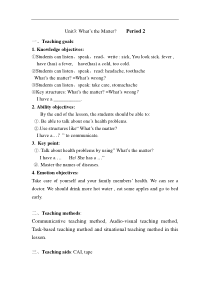 DOC
DOC
【文档说明】教科版(EEC)英语四年级下册《Unit 3 What’s the Matter Period 2》教学设计1.doc,共(8)页,62.500 KB,由小喜鸽上传
转载请保留链接:https://www.ichengzhen.cn/view-146192.html
以下为本文档部分文字说明:
Unit3:What’stheMatter?Period2一、Teachinggoals:1.Knowledgeobjectives:①Studentscanlisten、speak、read、write:sick,Youlooksick.fever,have(has)afever,have(h
as)acold,toocold.②Studentscanlisten、speak、read:headache,toothacheWhat’sthematter?=What’swrong?③Studentscanlisten、speak:takecare,stomachache④Keystruct
ures:What’sthematter?=What’swrong?Ihavea___________.2.Abilityobjectives:Bytheendofthelesson,thestudentsshouldbeableto:①.Beabletotalkaboutone’shealthp
roblems.②.Usestructureslike“What’sthematter?Ihavea…?”tocommunicate.3.Keypoint:①.Talkabouthealthproblem
sbyusing”What’sthematter?Ihavea…He/Shehasa…”②.Masterthenamesofdiseases.4.Emotionobjectives:Takecareofyourselfa
ndyourfamilymembers’health.Wecanseeadoctor.Weshoulddrinkmorehotwater,eatsomeapplesandgotobedearly.二、Teachingmethods:
Communicativeteachingmethod,Audio-visualteachingmethod,Task-basedteachingmethodandsituationalteachingmethodinthislesson.三、Tea
chingaids:CAI,tape四、TeachingProcedures:StepI:Greetings.StepII:Lead-inIshowsomepicturesandwordsabout“ck/k/”,suchasc
lock,black,Jack,sockandsoontoteach“sick”.Studentscanreadthewordsandfeelthepronunciation“ck,ck,ck/k//k//k/.T
:Canyoudotheactionabout“sick”?Studentscanactandreaditonebyone.Andonestudentact,otherstudentssay“Youlooksick”.(设计意图
:语音导入本课单词sick,让学生在读单词的同时自己总结发音规律读出所学单词。创设真实的情境,学生可以一边做动作一边学习Youlooksick,学生可以充分体会到在玩中学的轻松快乐。)StepIII:Presentation1.T:Lookatthepictureandask
thestudents“Whatisit”?Ss:headT:What’swrongwithhim?Thenwelearnache,readitandknowthemeaning.Thengirlsgroupread“head”,boysgroupread“ache”,theyrea
ditquickly,andletstudentsdotheactionandlearntheword“headache”.(设计意图:用学过的身体部位词head引出所学单词headache,并让学生猜一猜ache的意思,为下面所学单词做铺垫。学生自己创设情境,边做动作边读单词,有助于学生
记住所学单词。)2.Lookatthepicture,T:Whatarethey?What’swrongwithherteeth?Sheeatsmanycandies.S:teeth—tooth—toothacheT:Clever!tsa
ys/t/,oosays/u:/,thsays//Thenstudentscandotheactionlinebylineandreadtheword“toothache”.(设计意图:tooth这个词,学生之前没有接触过,分音节学习,且用单词卡分节去读词,学生
在学习headache的基础上容易准确的读出单词,并通过表演加深记忆。)3.Ididn’thavebreakfastthismorning.SoIhaveastomachache.T:Canyouactandreadthewor
dstomachache?Thenweshowstomach+ache=stomachache(设计意图:通过创设不同情境,自然地引出有关疾病的单词。这种教学单词的方式简单而且直观,学生乐意表演,在玩中学单
词,更易被学生接受,学生能够体会到合成词的意义。)4.Showsomewords(headache,toothache,stomachache).LetSsfindthesamepoint.设计意图:让学生自己总结规律,使学生有思考
的过程。5.T:Thisismypictures.LetSsguessWhat’sthematterwithme?Learnthewords:fever—haveafever,cold—haveacoldLearnthesentences:What’sthematter?=What
’swrong?(设计意图:运用老师的生活图片,学生感兴趣,积极的去猜,从而激起学生的求知欲。学生能够从情境中掌握同义句的含义。)6.Catch!Catch!Catch!T:Doyouknowaninterestinggame“catchthe
dolls”?Youcanreadthewordsquicklyanddotheaction“catch”(设计意图:运用学生熟知的游戏抓娃娃,让孩子们伴随欢快的音乐在快乐的气氛中快速读出所学单词和短语,对所学知识进行强化,尤其是haveaheadache/toothache/stomacha
che要求学生快速读出,难度递增。)7.Playagame(PK)T:Iwilldividemystudentsintotwogroups.(Boysgroupandgirlsgroup)Thegroupwhich
canactandspeak“Ihave_____.”correctlywillgetapples!OK!Comeon!Joinusquickly.(设计意图:运用PK的形式,激发学生的学习兴趣,巩固复
习所学的单词短语和句子。这个PK环节有助于培养学生小组合作意识和团队精神,训练学生眼疾手快的学习习惯,并且鼓励学生大胆表达,培养学生说出流利的口语。)8.WorkinpairsA:What’swrong?/What’sthematter?B:Ihav
ea…(设计意图:巩固复习刚才所学过的单词和短语,通过前面的学习和铺垫,以对话的形式熟练本课的句型,学生自己创设情境,表演病情,充分得到练习。)9.Showapictureofman.LetSstrytosay:Hehasafever.Playagam
e:Ishowsomestudents’pictures.Whenthepicturecomesout,allofthestudentssaythesentence“What’sthematter”?Th
enonestudentsay“Ihavea________”.Atlast,otherschangethesentence“He/Shehasa_________”(设计意图:这个环节能够激发学生的兴趣,学生看到自己班同学的照片很新奇,很有效的练
习第三人称单数,参与的人数多,形式多样,学生能够充分练习变第三人称单数。特别能照顾到学困生,认真听大家说,自己循序渐进学会三单。)10.Let’schant.stomachachestomachacheIhaveastomachache.备选栏:headachetoothachestomac
hachecoldfevercoldfeverheadacheheadacheHehasaheadache.toothachetoothacheShehasatoothache.feverfeverHehasafever.co
ldcoldShehasacold.(设计意图:本环节重在复习刚才学过的单词和句型。通过chant的形式有节奏的唱出,朗朗上口。在chant之前要注意引导学生look,readandchant.)StepIV:Con
solidation1.Cometothetext⑴Thefirsttimejustlistenfollowtheradio.⑵Thesecondtime,closeyourbooksandrecitethet
ext.Thenanswermyquestion,youcanchoose.What’sthematterwithKate?A:Shehasacold.B:Shehasafever.C:Shehasaheadache.Letstudentsguessthemea
ningof“toobad”and“takecare”.Andrememberthesentence“Takecareofyourself”.2.Dotheexercise,listenandwrite.(设计意图:本环节回归到文本,分两次让学生跟读课文,第一遍跟读模仿,读熟课文,第二遍
让学生合上书复述课文练听力。听完之后,处理文本中的难点,让学生联系上下文猜词义,为以后阅读练习做铺垫。听力练习有助于学生巩固课文知识,有效的练习三单。输出形式体现在写上,学生从做题结果上做自我评价。从而激励学生更加努力,认真。)3.T:Ihopethere’snotoothache
,noheadache,nofever.Allofusarehealthy.Socanyousaysomethingaboutadvice.Youcanusethesentences“Wecan/can’t_________.Don’t___________.”a.多运动
:run,walk,jump,swim,rideb.饮食:drinkhotwatereatapples/vegetablesc.习惯:gotobedearlyd.看医生:seeadoctor(设计意图:学生根据不同病情,各抒己见,发挥想象力,尝试用学过的词句表达
建议,提高自主学习能力。)4.MakeandactthedialogueD:Hi,Kate.What’sthematter?Youlooksick.P:Yes,Iam.Ihavea_________.D:G
ee,that’stoobad.Takecare.Youcan/can’t_____.P:Thankyou.(设计意图:所有的重难点进行整合,小组练习对话时扮演角色病人和医生,穿上白大褂戴上手术的帽子,激发学生的参与热情,同时在语句中理解tooba
d和takecare(ofyourself)之意。从而更加有效的巩固句型。尤其在拓展练习advice中,学生可以各抒己见,根据不同病情提出合理建议,提高学生的逻辑思考能力。)StepVHomework1.Copythewordsandphrase:fever,has,to
obad2.Makeasentenceusehaveacold/toothache/headache/stomachache/fever.3.Actoutthedialogue.Makeadialoguelikethetext.五、BlackboarddesignUnit3What
’sthematter?A:What’sthematter?=What’swrong?headachetoothacheB:Ihaveastomachachehasfevercold六、Teachingreflection本节课主要讲授病痛相关的单词,短语和句子。我运用多种操练方式,单词机械操练,
肢体语言,游戏,chant,PK,表演等方式完成教学目标。本节课我的教学设计环环相扣,难度递增,学生积极举手发言各抒己见,参与的热情很高,激发出了学生学习的主动性和表演天赋。我觉得不足之处是,PK环节可以训练学生速度
再快些。最后对话表演环节,鼓励学生能够背下来课文,表演再大胆一些,放开一些。
 辽公网安备 21102102000191号
辽公网安备 21102102000191号
 营业执照
营业执照